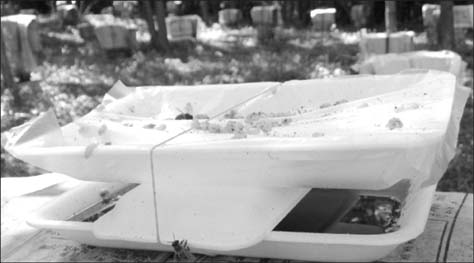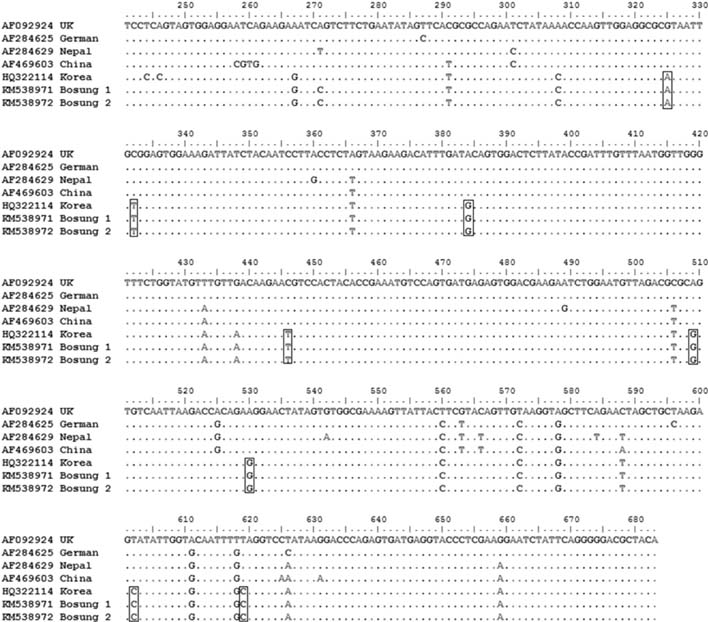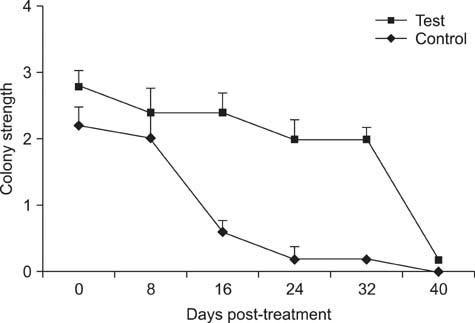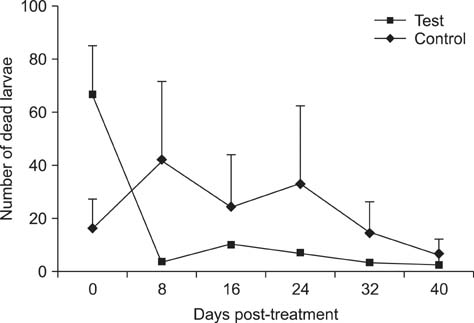J Vet Sci.
2015 Sep;16(3):289-295. 10.4142/jvs.2015.16.3.289.
Efficacy of silver ions against Sacbrood virus infection in the Eastern honey bee Apis cerana
- Affiliations
-
- 1Department of Parasitology, College of Veterinary Medicine, Chonnam National University, Gwangju 500-757, Korea. sungshik@jnu.ac.kr
- 2Department of Internal Medicine, College of Veterinary Medicine, Chonnam National University, Gwangju 500-757, Korea.
- 3Animal and Plant Quarantine Agency, Anyang 430-757, Korea.
- KMID: 2344301
- DOI: http://doi.org/10.4142/jvs.2015.16.3.289
Abstract
- Although silver is known to be a broad-spectrum biocidal agent, the effects of this metal against Sacbrood virus have not yet been investigated. In this study, we evaluated the efficacy of silver ions against natural Korean sacbrood virus (KSBV) infection of Apis (A.) cerana. Ten KSBV-infected colonies containing A. cerana with similar strength and activity were selected from an apiary located in Bosung-gun (Korea). Among these, five colonies were randomly assigned to the treatment group that was fed sugar syrup containing 0.2 mg/L silver ions. The other colonies were assigned to the untreated control group in which bees were given syrup without the silver ions. To assess the efficacy of the silver ions, colony strength, colony activity, and the number of dead larvae per hive were measured. During the experimental period, the test group maintained its strength and activity until day 32 while those of bees in the control group decreased sharply after day 8 to 16. Survival duration of the test group was significantly longer (40 days) than that of the control group (21 days). These results strongly indicated that silver ions are effective against KSBV infection in A. cerana.
Keyword
MeSH Terms
Figure
Reference
-
1. Akratanakul P. Beekeeping in Asia. Rome: Food and Agricultrue Organization;1986.2. Altschul SF, Gish W, Miller W, Myers EW, Lipman DJ. Basic local alignment search tool. J Mol Biol. 1990; 215:403–410.
Article3. Anderson DL, Gibbs AJ. Transpuparial transmission of Kashmir bee virus and sacbrood virus in the honey bee (Apis mellifera). Ann Appl Biol. 1989; 114:1–7.
Article4. Atiyeh BS, Costagliola M, Hayek SN, Dibo SA. Effect of silver on burn wound infection control and healing: review of the literature. Burns. 2007; 33:139–148.
Article5. Bailey L, Carpenter JM, Woods RD. A strain of sacbrood virus from Apis cerana. J Invertebr Pathol. 1982; 39:264–265.
Article6. Bailey L, Gibbs AJ, Woods RD. Sacbrood virus of the larval honey bee (Apis mellifera Linnaeus). Virology. 1964; 23:425–429.
Article7. Choe SE, Nguyen TTD, Hyun BH, Noh JH, Lee HS, Lee CH, Kang SW. Genetic and phylogenetic analysis of South Korean sacbrood virus isolates from infected honey bees (Apis cerana). Vet Microbiol. 2012; 157:32–40.
Article8. Choi YS, Lee ML, Hong IP, Kim NS, Kim HK, Lee KG, Lee ML. Occurrence of sacbrood virus in Korean apiaries from Apis cerana (Hymenoptera: Apidae). J Apic. 2010; 25:187–191.9. Dong BY, Fang YZ, Guo ZQ, Li XJ, Zhang Y, Bi KH. Study on Chinese sacbrood bee virus. Apic China. 1986; 2:6–8.10. Dong BY, Yuan YD, Zhang GC, Guo ZQ, Liu JS. Study on serological relationships or mutual susceptibility of CSBV and SBV. Apic China. 1984; 3:8–9.11. Environmental Protection Agency (US). Integrated Risk Information System: Silver (CASRN 7440-22-4). Washington: US Environmental Protection Agency;1995. .12. Grabensteiner E, Ritter W, Carter MJ, Davison S, Pechhacker H, Kolodziejek J, Boecking O, Derakhshifar I, Moosbeckhofer R, Licek E, Nowotny N. Sacbrood virus of the honeybee (Apis mellifera): rapid identification and phylogenetic analysis using reverse transcription-PCR. Clin Diagn Lab Immunol. 2001; 8:93–104.
Article13. Hall TA. BioEdit: a user-friendly biological sequence alignment editor and analysis program for Windows 95/98/NT. Nucleic Acids Symp Ser (Oxf). 1999; 41:95–98.14. Jung WK, Koo HC, Kim KW, Shin S, Kim SH, Park YH. Antibacterial activity and mechanism of action of the silver ion in Staphylococcus aureus and Escherichia coli. Appl Environ Microbiol. 2008; 74:2171–2178.
Article15. Kevan PG. The Asiatic Hive Bee: Apiculture, Biology, and Role in Sustainable Development in Tropical and Subtropical Asia. Cambridge: Enviroquest;1995.16. Kim JS, Kuk E, Yu KN, Kim JH, Park SJ, Lee HJ, Kim SH, Park YK, Park YH, Hwang CY, Kim YK, Lee YS, Jeong DH, Cho MH. Antimicrobial effects of silver nanoparticles. Nanomedicine. 2007; 3:95–101.
Article17. Lara HH, Garza-Treviño EN, Ixtepan-Turrent L, Singh DK. Silver nanoparticles are broad-spectrum bactericidal and virucidal compounds. J Nanobiotechnology. 2011; 9:30.
Article18. Liu X, Zhang Y, Yan X, Han R. Prevention of Chinese sacbrood virus infection in Apis cerana using RNA interference. Curr Microbiol. 2010; 61:422–428.
Article19. Lu L, Sun RW, Chen R, Hui CK, Ho CM, Luk JM, Lau GK, Che CM. Silver nanoparticles inhibit hepatitis B virus replication. Antivir Ther. 2008; 13:253–262.20. Mehrbod P, Motamed N, Tabatabaian M, Soleimani Estyar R, Amini E, Shahidi M, Kheiri MT. In vitro antiviral effect of "Nanosilver" on influenza virus. Daru. 2009; 17:88–93.21. Ongus JR, Peters D, Bonmatin JM, Bengsch E, Vlak JM, van Oers MM. Complete sequence of a picorna-like virus of the genus Iflavirus replicating in the mite Varroa destructor. J Gen Virol. 2004; 85:3747–3755.
Article22. Rana BS, Garg ID, Khurana SMP, Verma LR, Agrawal HO. Thai sacbrood virus of honeybees (Apis cerana indica F) in North-west Himalayas. Indian J Virol. 1986; 2:127–131.23. Ratte HT. Bioaccumulation and toxicity of silver compounds: a review. Environ Toxicol Chem. 1999; 18:89–108.
Article24. Saville NM. Battling with bee brood disease in Apis cerana in W. Nepal-some findings. In : Proceeding of the Seventh IBRA Conference on Tropical Bees: Management and Diversity, and Fifth Asian Apicultural Association Conference; 19-25 March 2000; Chiang Mai, Thailand.25. Verma LR, Rana BS, Verma S. Observations on Apis cerana colonies surviving from Thai sacbrood virus infestation. Apidologie. 1990; 21:169–174.
Article26. Yoo MS, Lee DW, Kim IW, Kim DS, Kwon SH, Lim YG, Yoon BS. Identification of Black queen cell virus from the honeybee in Korea. J Apic. 2007; 22:43–52.27. Zhang J, Feng J, Liang Y, Chen D, Zhou ZH, Zhang Q, Lu X. Three-dimensional structure of the Chinese sacbrood bee virus. Sci China C Life Sci. 2001; 44:443–448.
Article28. Zhao G, Stevens SE Jr. Multiple parameters for the comprehensive evaluation of the susceptibility of Escherichia coli to the silver ion. Biometals. 1998; 11:27–32.
- Full Text Links
- Actions
-
Cited
- CITED
-
- Close
- Share
- Similar articles
-
- Prevalence of Nosema and Virus in Honey Bee (Apis mellifera L.) Colonies on Flowering Period of Acacia in Korea
- In vitro Biphasic Effect of Honey Bee Venom on Basophils from Screened Healthy Blood Donors
- Bee Venom Therapy for Musculoskeletal Disorders
- Cerebral Infarction after Honey Bee Venom Acupuncture
- Foreign Body Granuloma Following Dried Honey Bee Venom (Apitoxin Inj) Injection







